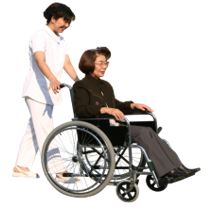
By Team Seaglass
In the realm of healthcare, the physical demands placed on caregivers are immense, and one often underestimated task contributing to these demands is pushing and pulling wheelchairs. This seemingly routine activity, however, carries inherent risks that can lead to injuries for healthcare workers. Understanding these challenges and proactively addressing them is crucial for the well-being of both the caregiver and the patient
Take Sally, for example. Sally is a 45-year-old nurse with many years of experience working with residents in skilled nursing facilities. She loves the relationships she’s developed with the residents at her center, and on warm summer days, she often pushes residents into the garden where she shares quality time with them. But recently, Sally injured her shoulder while transporting a resident via a wheelchair. Now Sally is out of work due to her injury which has greatly saddened both herself as well as the many residents that have come to rely on Sally’s friendship and assistance.
This issue is not necessarily due to the wheelchair itself, but a myriad of other contributing factors over time, that ultimately positioned Sally to sustain this crippling injury. In this month’s blog, we will discuss the many factors that contribute to muscle strains involving the handling of wheelchairs, and what caregivers can do to reduce their risk for injury.
Risks Faced by Healthcare Workers
- Musculoskeletal Strain: The repetitive nature of pushing and pulling wheelchairs can lead to musculoskeletal injuries affecting the back, shoulders, and wrists of healthcare workers.
- Awkward Maneuvering: Traditional wheelchairs can be heavy, requiring significant effort to maneuver, especially in tight spaces or over uneven surfaces, increasing the risk of collisions, falls, and injuries for both the caregiver and the patient.
- Limited Visibility: Caregivers may face challenges in visibility, especially when maneuvering in low lighting, crowded places, or housekeeping restrictions.
- Patient-Related Risks: Wheelchair mobility involves interacting with patients who may have varying levels of cooperation or physical stability, adding an element of unpredictability to the task.
- Wheelchair Design: Wheelchairs that lack ergonomic features can contribute to poor body mechanics leading to cumulative discomfort.
Reducing the Risk of Injury
- Invest in Lightweight Wheelchairs: Consider providing lightweight and easily maneuverable wheelchairs that reduce the physical strain on caregivers and promote smoother mobility. Utilize specialty wheelchairs for bariatric patients, as these devices are designed for bariatric needs.
- Add Ergonomic Adjustments to Wheelchairs: Invest in wheelchairs with ergonomic features, such as adjustable handles and easily maneuverable wheels to reduce caregiver strain and enhance patient comfort.
- Consider Use of Mechanical Aids: Explore the use of power-assist wheelchairs, especially for patients with significant challenges. Manual wheelchairs need more force applied to move them, while power-assist devices are mechanisms attached to the wheelchair that apply mechanical force with only minimum effort necessary from the caregiver.
- Provide Wheelchair Operational Training: Don’t underestimate the power of training. Wheelchairs may seem easy to operate, but they can be quite challenging under different circumstances. Caregivers need to be trained in the proper operation of wheelchairs as well as effective communication with patients during wheelchair mobility.
- Complete Routine Wheelchair Maintenance: Establish a routine maintenance schedule for wheelchairs to ensure they are in optimal condition, reducing the likelihood of malfunctions that could lead to accidents
While operating a wheelchair safely is an integral part of caregiving in healthcare, it is essential that healthcare management recognize and mitigate the associated risks to prevent injuries. By investing in training, equipment, and safety protocols, healthcare management can create a safer and more supportive environment for caregivers, ultimately enhancing the quality of care provided to patients and promoting the overall well-being of the healthcare workforce.

